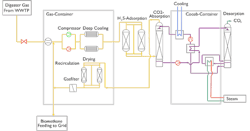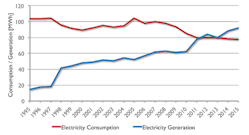German utility Hamburg Wasser is expecting its electricity production to exceed consumption by 15% and this year half its energy bills to €4 million. Using a combination of on-site biogas and wind energy, the water company explains why merging conventional and unconventional thinking led to a win-win solution.
By Lueder Garleff
Germany's largest wastewater treatment plant (WWTP) "Köhlbrandhöft / Dradenau" processes the wastewater of almost two million people and the industry of Europe's third biggest seaport. Operated by Hamburg Wasser with an electricity demand of 80 MWh p.a. it is still one of the biggest public energy consumers in the city.
Before 1995 the energy-world was relatively simple: the energy demand was covered by electricity bought from the local supplier and natural gas from the grids. There was a monopoly of grid operators and a very small range for negotiating energy prices in Germany at that time. Climate change and renewable energy were not yet the main topics in public discussions.
Only with the liberalisation of the electricity market in 1998, energy management had a real chance to combine technical and economic aspects to gain considerable benefits. This prospect then made Hamburg Wasser address energy management with the task to reduce energy costs using legal, economic and technical framework conditions. These aspects became more and more important, when energy prices increased from 2004 onwards.
Following the urging challenges to counter climate change, the utility enforced its efforts and defined the official target to create an energy-self-sufficient WWTP until 2011. By doing this, the public owned company also supported the political targets of the Free and Hanseatic City of Hamburg, as the official "European Green Capital" of 2011.
1st approach: sludge energy
The first and most important technical change arose from changing conditions for the disposal of sewage sludge in the early 1990s. Hamburg, as a city with high population density, had always dumped its sewage sludge on landfills. Due to the high amounts of sludge, agricultural use ceased to be an option because transporting the sludge became more and more expensive.
Instead, digesting the sludge on site was a way to decrease the amount of sludge. In a first development phase, the digester gas was then used for heating the digesters, but not for effective electricity production. When sludge disposal on landfills was prohibited, Hamburg decided to invest in a high-tech solution to dry and incinerate the sewage sludge in a combined process with the usage of digester gas for electricity generation. The incineration plant named VERA was put into operation in 1998 as a showcase project of the World Exhibition 2000 in Hannover, Germany. Today it is still the backbone of the treatment plant´s energy supply.
After mechanical dewatering and thermal drying the sludge is incinerated in fluidised bed incinerators. The heat is used to produce steam, driving a steam turbine for electricity production. So far the process is similar to common power plant technology. The highlight, however, is the very close interconnection of heat and digester gas systems. VERA covers the high heat demand of the thermal sludge drying plant on a high temperature level.
For this purpose, steam is withdrawn from the two-stage steam turbine from a tapping behind the first stage. The residual waste heat of the thermal drying process on a low temperature level is subsequently used to supply the digesters, all buildings of the WWTP and -- since 2009 - even the neighboring container terminal of the Hamburg seaport. By this, the heat demand was covered by 109% in 2013.
Efficient digester gas
Using digester gas for electricity generation has become a general standard solution for wastewater treatment plants. In Hamburg this is also integrated in the VERA. Digester gas is combusted in a gas turbine of 5 MW and a gas engine of 2 MW rated power. The exhaust waste heat is then again used for steam production, feeding the same steam turbine as the sludge incineration. This combination leads to a very high electrical efficiency of 42%.
However, energy self-sufficiency could not have been gained solely by extending energy production. Reducing energy consumption is equally important and more valuable from the ecological point of view. As a result, Hamburg Wasser implemented a number of projects as a result of a systematic data acquisition and analysis of the energy demand of every single sub-process. For example, a modern aeration system reduces the plant's electricity demand by almost 18%, several additional projects lead to an overall saving of more than 20%.
Filling the gap: wind energy for industrial self provision
The geographical situation of Hamburg not too far from the North Sea provides a considerable potential for using wind energy.
However, the idea of using it for self-provision of an industrial plant was not that common and required new legal and contractual models for energy procurement and sale. Furthermore, the turbines had to be equipped with advanced and multiple safety systems e.g. for ice detection, machine monitoring, fire extinguishing. This was required to ensure that the plant could not pose any risk to the WWTP itself, but also for the surrounding container terminals and seaport traffic.
Nevertheless, the utility installed three wind turbines with an overall rated power of 8 MW. With their hub height of 140 m and rotor diameter of more than 100 m they are now part of the seaport skyline.
Even though wind power is not an obviously reliable source, the yearly balance of energy consumption and production today reveals a remarkable energy surplus.
The Surplus: feeding digester gas into the natural gas grid
The amount of digester gas production was significantly increased by co-fermentation of various types of biological wastes.
This was initially also intensified regarding the revenues from this business and became more and more important for reducing the energy demand and costs. Since it became clear that the gas production would soon exceed the usage capacities, Hamburg Wasser had to decide about the right technology for extending these capacities.
The simple way -- increase of electricity generation -- was obviously not the best, since there was no use for the extra heat. Even the electricity self-sufficiency was already in sight. The solution was not to use the gas for self provision, but to sell it to the natural gas grid.
Due to the different contents and qualities of digester and natural gas, a plant for upgrading the digester gas has been installed -- one of the first plants using that technology, running on digester gas. The main task is to remove carbon dioxide from the raw digester gas, which is done by an amine scrubbing process. This treatment was chosen, because it requires heat as auxiliary energy for regeneration of the amine suspension.
Heat demand again can be covered from the sludge incineration in a very efficient and economic way. The whole plant is constructed in a modular container based unit and turned out to be a very reliable system. It can be controlled very flexibly and is therefore also used to control the digester gas usage according to the actual electricity demand of the WWTP.
Win win
From 1995 onwards, the electricity consumption has been reduced from more than 100 GWh p.a. to less than 79 GWh p.a. At the same time, the renewable electricity generation increased to more than 80 GWh p.a. Both trends will continue in the future as further projects are under construction. At the final stage the electricity production will exceed consumption by 15%. Concerning heat supply, a continuous surplus of almost 10% has already been achieved since 2010.
Every single project, of course, has to pass a thorough payback analysis. If technical approaches are failing in this aspect, they are reassessed when changing frame conditions, giving reasons to expect a positive result. Thus the savings of energy costs exceed by far the operation and capital expenditures of the implemented projects. The overall balance of energy procurement expenditures, revenues from energy sale, operation and capital costs of energy production will decrease from €8.7 million in 2009 to about €4 million in 2015 -- and that almost without any public subsidies.
Another economic aspect is almost as important: energy costs have become predictable now and almost independent from volatile energy prices. Since 2007, the electricity price continuously increased by 65% - almost 10% p.a!
At the same time energy costs for the WWTP decreased by 30% and are on a constant level for three years now, since they are more and more dominated by capital costs, not by energy markets.
After all, the energy concept has come to an ecological and economic success, which already stimulated similar strategies in other German cities and attracts worldwide attention -- and we are still moving forward.
Author's note: Lueder Garleff is in the energy management team at Hamburg Wasser. More information on the utility can be found at: www.hamburgwasser.de
More Water & WasteWater International Archives Issue Articles







